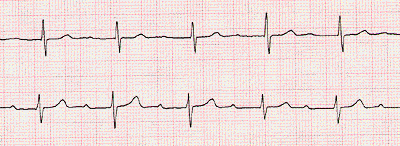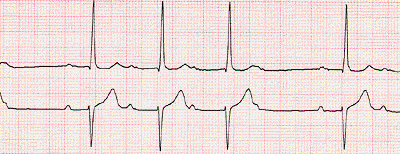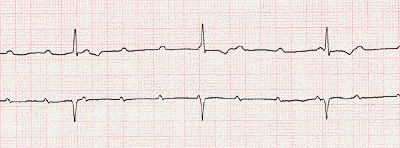Anesthesia Pharmacology Chapter 7: Autonomic Cholinergic Pharmacology
Anticholinergic Drugs -- Anesthesia Applications/Issues
Overview:
Preoperative medication
Management of reflex bradycardia
Use in antagonism of nondepolarizing neuromuscular-blocking agents
Common Applications-- anesthesia related (anticholinergic agents)
Preoperative medications
Management of reflex bradycardia
Combinations with anticholinesterase agents during pharmacological antagonism of nondepolarizing neuromuscular-blocking agents
Other Applications of anticholinergic drugs:
bronchodilation (e.g.,asthma)
biliary/ureteral smooth muscle relaxation
to cause mydriasis/cycloplegia
inhibition of parietal cells acid secretion
prevention of motion sickness (nausea)
component in cold remedies
Central Nervous System Effects of Antimuscarinic Agents
In normal doses, atropine produces little CNS effect.
In toxic doses, CNS excitation results in restlessness, hallucinations, and disorientation.
At very high doses, atropine can lead to CNS depression which causes circulatory and respiratory collapse.
By contrast, scopolamine at normal therapeutic doses causes CNS depression, including drowsiness, fatigue and amnesia.
Scopolamine also may produce euphoria, a basis for some abuse potential.
Scopolamine may exhibit more CNS activity than atropine because scopolamine crosses the blood brain barrier more readily.
Antimuscarinics are used clinically as preanesthetic medication to reduce vagal effects secondary to visceral manipulation during surgery.
Antimuscarinics with L-DOPA are used in Parkinson's disease.
Extrapyramidal effects induced by some antipsychotic drugs may be treated with antimuscarinic agents.
Scopolamine (transdermal) is effective in preventing motion sickness.
Atropine is also an effective antidote to excessive cholinergic stimulation following organophosphate intoxication.
By blocking muscarinic receptors, the consequences of cholinesterase inhibition is attentuated.
Atropine may be used in conjunction with 2-PAM which may reactivate phosphorylated, inhibited acetylcholinesterase by nucleophilic displacement.
Primary current therapeutic rationale:
Sedation
Antisialagogue
Historical: IM atropine was used prior to anesthesia induction to limit excessive salivary secretion and reduce vagal reflex influence on the heart
current inhaled/injected anesthetic agents are not consistently associated with these effects
Anticholinergic drugs are not mandatory as part of preoperative medication
Gastrointestinal effects:
Usual anticholinergic drug doses for preoperative medication (and adults) does not affect either gastric volume or pH
Special considerations:
Patients with glaucoma:
mydriatic effects of scopolamine > atropine; caution with scopolamine use in patients with glaucoma
atropine + anticholinesterase causes little/no change in pupil size, therefore appearing apparently safe
Glycopyrrolate (Robinul): least effect on pupil size of all anticholinergic drugs used in preoperative medication
Parturients:
atropine & scopolamine: crosses the placenta; fetal heart rate-- not significantly changed following atropine or glycopyrrolate IV administration
Scopolamine is preferred when sedation is the objective for including anticholinergic drug in preoperative medication
Atropine:
less sedation compared to scopolamine
associated with increased incidence of memory deficit associated with anesthesia, compared to glycopyrrolate
delayed arousal in the first 30 minutes after anesthesia if atropine-neostigmine mixtures were used to antagonize nondepolarizing neuromuscular-blocking drug effects {compared to glycopyrrolate-neostigmine mixtures}
Scopolamine enhances significantly sedative effects of other drugs administered at the same time, i.e. benzodiazepines and opioids
Scopolamine plus morphine: reliable preanesthetic sedation
Glycopyrrolate (Robinul): does not readily cross the blood-brain barrier; no sedative effects
CNS effects of anticholinergic drugs -- particularly scopolamine:
restlessness or somnolence
such symptoms more likely to occur in the elderly
inhaled anesthetics may potentiate anticholinergic CNS drug effects«increased postoperative restlessness/somnolence incidence
Treatment of Reflex-Mediated Bradycardia
Anticholinergic drugs: drugs of choice for management of intraoperative bradycardia --especially if due to increased vagal tone
First Degree Heart Block

|
P Wave |
PR Interval |
QRS (sec.) |
Characteristics |
|
Before each QRS (identical) |
> 0.20 |
< 0.12 |
Regular |
Marquette Medical Systems, Inc (http://www.mei.com)
Second Degree AV Block (Mobitz Type I)

|
P Wave |
PR Interval |
QRS (sec.) |
Characteristics |
|
Conduction Intermittent |
Increasingly Prolonged |
< 0.12 |
QRS dropped in a repeating pattern |
Marquette Medical Systems, Inc (http://www.mei.com)
Third Degree (Complete) Block
Atropine increases heart rate (by blocking acetylcholine effects on the SA node)
Young adults are most sensitive to atropine effects on heart rate {higher vagal tone} compared to infants or elderly patients
in the elderly: atropine may have no effect on heart rate
During anesthesia with a volatile agent, atropine dosage required to raise the heart rate may be less than that required in an awake patient -- suggesting vagal center depression during anesthesia

|
P Wave |
PR Interval |
QRS (sec.) |
Characteristics |
|
Normal but not related to QRS |
none |
N/A |
No relationship between P & QRS complex |
Marquette Medical Systems, Inc (http://www.mei.com)
Halothane (Fluothane) (like opioids) probably increases central vagal tone, explaining why atropine administration is more likely to result in an increase in heart rate compared to patients anesthetize with enflurane (Ethrane).
Antagonist-assisted neuromuscular-blockade reversal
Edrophonium (Tensilon), neostigmine (Prostigmin), or pyridostigmine (Mestinon)-- effective by increasing acetylcholine availability of neuromuscular junction {secondary to acetylcholinesterase inhibition}
Physostigmine (Antilirium): not used because dosage requirement is excessive
Anticholinesterase agents are usually administered during spontaneous neuromuscular-blockade recovery
Recovery rate is the sum of:
(1) spontaneous recovery from the blocking drug and
(2) the activity of the pharmacologic antagonist (anticholinesterase drugs)
Therefore: pharmacologic antagonism is more effective for short-or intermediate-acting neuromuscular-blocking drugs (undergoing plasma hydrolysis or Hoffmann elimination) compared to long-acting nondepolarizing neuromuscular-blocking agents
Special Considerations: use of muscarinic antagonists with anticholinesterases in Reversal of Neuromuscular Blockade
Reversal of nondepolarizing neuromuscular-blockade: necessitates only nicotinic cholinergic effects of anticholinesterases agents
Minimizing muscarinic receptor-mediated effects of anticholinesterase drugs is beneficial an accomplished by a concurrent administration of atropine or glycopyrrolate (antimuscarinics)
The antimuscarinic agent should have a more rapid onset than the anticholinesterase drugs -- reducing drug-induced bradycardia
if edrophonium (Tensilon)(0.5 mg/kg) is used; atropine 7 Ág/kg is appropriate
a higher dose atropine (10-15 Ág/kg) has been recommended, particularly if nonopioid-based maintenance anesthetic has been used
if neostigmine is used (slower onset of action compared edrophonium (Tensilon)), then atropine or glycopyrrolate (Robinul) may be administered as the antimuscarinic agent;
concurrent administration of these drugs results in an initial tachycardia because of atropine's more rapid onset
Factors influencing the speed and extent of neuromuscular blockade reversal by anticholinesterase agents
intensity neuromuscular-blockade when reversal is initiated (train-of-four visible twitches)
which nondepolarizing neuromuscular-blocking drug is being reversed
Edrophonium (Tensilon): less effective than neostigmine in reversing deep neuromuscular blockade (twitch height < 10% of control) produced by continuous atracurium (Tracrium), vecuronium (Norcuron), or pancuronium (Pavulon) infusions.
Edrophonium (Tensilon), probably better than neostigmine (Prostigmin)for reversing atracurium (Tracrium)blockade
Neostigmine (Prostigmin), probably better than edrophonium (Tensilon) for reversing vecuronium (Norcuron) blockade
Prevention/inhibition of anticholinesterase-mediated antagonism of neuromuscular-blockade -- Possible factors
certain antibiotics
hypothermia
respiratory acidosis (PaCO2 >50 mm Hg
hypokalemia/metabolic acidosis
Reversal of phase II block (following prolonged/repeated succinylcholine (Anectine)): may be reversed with edrophonium (Tensilon) or neostigmine (Prostigmin) in patients with normal plasma cholinesterase
in patients with atypical plasma cholinesterase, phase II block reversal may not be reliable, requiring mechanical ventilation until blockade subsides.
Bronchodilation following anticholinergic drug administration is due to blockade of acetylcholine effects on airway smooth muscle muscarinic receptors.
Extent of the response depends on vagal tone (pre-existing bronchomotor tone)
e.g. a clinical dose of scopolamine may decrease airway resistance and increase dead space by about 1/3
Preferred Route of Administration for bronchodilation: aerosol
Ipratropium (Atrovent):anticholinergic drug most commonly used for aerosol administration -- synthetic quaternary ammonium atropine congener
most effective in preventing/treating bronchospasm due to ▀-adrenergic antagonists
more effective than ▀-adrenergic agonists in producing bronchodilation in patients with chronic bronchitis or emphysema (high cholinergic tone)
Patients with bronchial asthma: usually respond better to beta-agonist because of direct smooth muscle relaxation through beta-receptor activation and by inhibition of histamine & leukotriene release (chemical mediators of smooth muscle contraction)
Stoelting, R.K., "Anticholinesterase Drugs and Cholinergic Agonists", in Pharmacology and Physiology in Anesthetic Practice, Lippincott-Raven Publishers, 1999, 241-244
Vagal effects on the gut are mediated not only by acetylcholine but also by actions on intramural serotonergic and dopaminergic neurons.
Atropine can block Ach effects while having no effect on non-cholinergic modulation of GI motility.
Vagal input affects gastrin release and may be blocked by atropine; however, gastric acid release is more effectively prevented by M1 specific antimuscarinic drugs (pirenzapine) and H2-selective histamine receptor blockers.
Brown, J.H and Taylor, P. Muscarinic Receptor Agonists and Antagonists In, Goodman and Gillman's The Pharmacologial Basis of Therapeutics,(Hardman, J.G, Limbird, L.E, Molinoff, P.B., Ruddon, R.W, and Gilman, A.G.,eds) The McGraw-Hill Companies, Inc.,1996, pp.149-159.
Parasympathetic activity produces bronchoconstriction.
Activation of nicotinic and M1-muscarinic receptors is parasympathetic ganglia which lie in the airway wall then activate postganglionic fibers.
These postganglionic fibers release acetylcholine which activate M3 muscarinic receptors which produce bronchiolar smooth muscle contraction. M2 receptors may also be present.
Muscarinic antagonists attenuate pulmonary smooth muscle constriction, often resulting in bronchodilation.
The magnitude of the effect depends on the basal parasympathetic tone.
Ipratropium bromide has been prominent in treating respiratory disease.
|
Agonists |
Antagonists |
Tissue |
Responses |
Molecular Aspects |
|
acetylcholine, methacholine |
atropine |
Smooth muscle |
Contraction |
Phospholipase C (PLC) stimulation through Gq/11 formation: (IP3 ) + diacylglycerol (DAG): increased cytosolic Ca2+ |
|
Secretory glands |
Increased Secretion |
Atropine and other antimuscarinic inhibit mouth, bronchial, and pharyngeal secretion which reduce reflex laryngospasm during general anesthesia.
Also, atropine or other antimuscarinics are given during general anesthesia to blunt increases in vagal tone due to mechanical effects on viscera during abdominal surgeries.
Antimuscarinics, especially ipratropium, along with sympathomimetics, are useful in management of asthma. Ipratropium (Atrovent) has an advantage in asthma compared to atropine because:
ipratropium does not inhibit mucociliary clearance (atropine does)
ipratropium has no significant CNS effects.
Inhaled ipratropium (a quaternary, charge molecule) has limited or no systemic effects.
ipratropium is more effective that beta-adrenergic agonists in COPD (cholinergic tone may be the only component that may be attenuated)
Muscarinic receptor antagonists block parasympathetic responses of the ciliary muscle and iris sphincter muscle, resulting in paralysis of accommodation (cycloplegia) and mydriasis (pupillary dilation).
Mydriasis results in photophobia, whereas cycloplegia fixes the lens for far vision only (near objects appear blurred).
Systemic atropine at usual doses does not produce significant ophthalmic effect.
By contrast, systemic scopolamine results in both mydriasis and cycloplegia.
Note that sympathomimetic-induced mydriasis occurs without loss of accommodation.
Atropine-like drugs can increase intraocular pressure, sometimes dangerously, in patients with narrow-angle glaucoma.
Increases in intraocular pressure is not typical in wide-angle glaucoma.
Cholinergic Blockers:Adverse effects
Dry mouth (xerostromia)
Blurred vision (cycloplegia)
Photophobia (mydriasis)
Ganglionic blockers act mainly at the primary nicotinic-type cholinergic receptor at sympathetic and parasympathetic autonomic ganglia.
Agents which are classified as ganglionic blockers are not included among those drugs which block neuromuscular junctions.
One class of blocker produces a depolarization block: Nicotine could produce this effect.
The second class of agents include hexamethonium & trimethaphan These agents either competitively block the receptor or block the open channel configuration.
For essential hypertension, ganglionic blockers have been replaced by better drugs.
Ganglionic blockers may be used for initial blood pressure control in patients with dissecting aortic aneurysm because, in addition to reducing blood pressure, blunting of sympathetic responses reduce sheer forces at the tear.
Taylor, P. Agents Acting at the Neuromuscular Junction and Autonomic Ganglia In, Goodman and Gillman's The Pharmacologial Basis of Therapeutics,(Hardman, J.G, Limbird, L.E, Molinoff, P.B., Ruddon, R.W, and Gilman, A.G.,eds) The McGraw-Hill Companies, Inc.,1996, pp.193-195
|
Antatomical Site |
Predominant Autonomic Tone |
Effect of Ganglionic Blockade |
|
Arterioles |
Sympathetic-adrenergic |
vasodilatation; increased peripheral blood flow; hypotension |
|
Veins |
Sympathetic-adrenergic |
dilatation; blood pooling; decreased venous return; decreased cardiac output |
|
Heart |
Parasympathetic-cholinergic |
tachycardia |
|
Ciliary Muscle |
Parasympathetic-cholinergic |
cycloplegia (loss of accommodation) |
|
Gastrointestinal Tract |
Parasympathetic-cholinergic |
reduced tone and motility; constipation; decreased secretions |
|
Salivary Glands |
Parasympathetic-cholinergic |
Xerostomia (dry mouth) |
|
Sweat Glands |
Sympathetic-cholinergic |
Anhidrosis (lack of sweating) |
Taylor, P. Agents Acting at the Neuromuscular Junction and Autonomic Ganglia In, Goodman and Gillman's The Pharmacologial Basis of Therapeutics,(Hardman, J.G, Limbird, L.E, Molinoff, P.B., Ruddon, R.W, and Gilman, A.G.,eds) The McGraw-Hill Companies, Inc.,1996, pp.193-195. Adapted from Table 9-3.